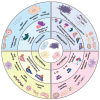PANoptosis in Bacterial Infections: A Double-Edged Sword Balancing Host Immunity and Pathogenesis
- PMID: 39861004
- PMCID: PMC11768250
- DOI: 10.3390/pathogens14010043
PANoptosis in Bacterial Infections: A Double-Edged Sword Balancing Host Immunity and Pathogenesis
Abstract
PANoptosis is a newly identified programmed cell death pathway that integrates characteristics of apoptosis, pyroptosis, and necroptosis. It plays a dual role in the host immune response to bacterial infections. On one hand, PANoptosis acts as a protective mechanism by inducing the death of infected cells to eliminate pathogens and releasing pro-inflammatory cytokines to amplify the immune response. On the other hand, bacteria can exploit PANoptosis to evade host immune defenses. This dual nature underscores the potential of PANoptosis as a target for developing novel therapies against bacterial infections. This review summarizes the molecular mechanisms of PANoptosis, along with the crosstalk and integration of different cell death pathways in response to various bacterial pathogens. We also discuss the dual roles of PANoptosis in bacterial infectious diseases, including sepsis, pulmonary infections, and intestinal infections. Elucidating the molecular mechanisms underlying PANoptosis and how bacteria manipulate this pathway offers critical insights into host-pathogen interactions. These insights provide a foundation for designing targeted antibacterial strategies, modulating inflammation, and advancing precision medicine to improve clinical outcomes.
Keywords: PANoptosis; bacterial infection; bacterial infectious disease; host–pathogen interactions; programmed cell death.
Conflict of interest statement
The authors declare no conflicts of interest.
Figures



Similar articles
-
PANoptosis in microbial infection.Curr Opin Microbiol. 2021 Feb;59:42-49. doi: 10.1016/j.mib.2020.07.012. Epub 2020 Aug 20. Curr Opin Microbiol. 2021. PMID: 32829024 Free PMC article. Review.
-
PANoptosis: A New Insight Into Oral Infectious Diseases.Front Immunol. 2021 Dec 14;12:789610. doi: 10.3389/fimmu.2021.789610. eCollection 2021. Front Immunol. 2021. PMID: 34970269 Free PMC article. Review.
-
Hierarchical Cell Death Program Disrupts the Intracellular Niche Required for Burkholderia thailandensis Pathogenesis.mBio. 2021 Jun 29;12(3):e0105921. doi: 10.1128/mBio.01059-21. Epub 2021 Jun 22. mBio. 2021. PMID: 34154417 Free PMC article.
-
It's All in the PAN: Crosstalk, Plasticity, Redundancies, Switches, and Interconnectedness Encompassed by PANoptosis Underlying the Totality of Cell Death-Associated Biological Effects.Cells. 2022 Apr 29;11(9):1495. doi: 10.3390/cells11091495. Cells. 2022. PMID: 35563804 Free PMC article. Review.
-
Molecular mechanism of PANoptosis and programmed cell death in neurological diseases.Neurobiol Dis. 2025 Jun 1;209:106907. doi: 10.1016/j.nbd.2025.106907. Epub 2025 Apr 11. Neurobiol Dis. 2025. PMID: 40204169 Review.
Cited by
-
PANoptosis as a Two-Edged Sword in Colorectal Cancer: A Pathogenic Mechanism and Therapeutic Opportunity.Cells. 2025 May 16;14(10):730. doi: 10.3390/cells14100730. Cells. 2025. PMID: 40422233 Free PMC article. Review.
-
Cell death in acute lung injury: caspase-regulated apoptosis, pyroptosis, necroptosis, and PANoptosis.Front Pharmacol. 2025 Mar 21;16:1559659. doi: 10.3389/fphar.2025.1559659. eCollection 2025. Front Pharmacol. 2025. PMID: 40191423 Free PMC article. Review.
-
Stress granules and cell death: crosstalk and potential therapeutic strategies in infectious diseases.Cell Death Dis. 2025 Jul 5;16(1):495. doi: 10.1038/s41419-025-07800-z. Cell Death Dis. 2025. PMID: 40617807 Free PMC article. Review.
References
Publication types
MeSH terms
Grants and funding
- 82102431/National Natural Science Foundation of China
- 32070138/National Natural Science Foundation of China
- lzujbky-2023-eyt04/the Fundamental Research Funds for the Central Universities
- yjrckyqdj-2021-03/Talent Introduction Plan of the Second Hospital of Lanzhou University
- CY2021-MS-A05/Cuiying Scientific and Technological Innovation Program of the Second Hospital of Lanzhou University
LinkOut - more resources
Full Text Sources
Medical

